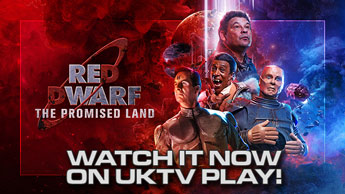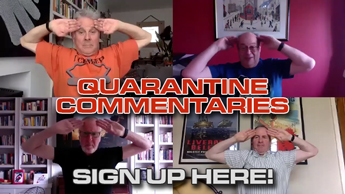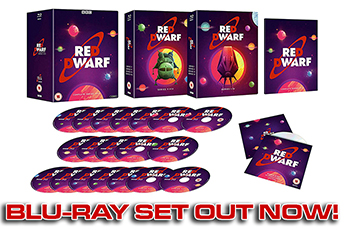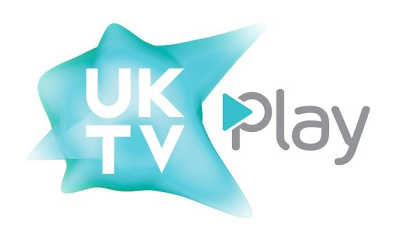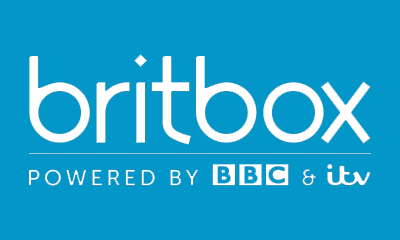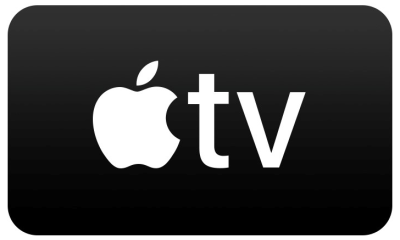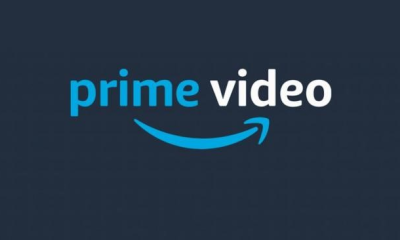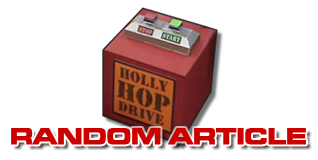 |
Marked For Time Red Dwarf has always been known as a demanding show for editors. Those who brave the challenge of getting the lengthy episodes down to a 28 minute time for broadcast must prepare for late nights and a lot of coffee. Mr Flibble meets the man who slices the footage. |

Andrew Ellard
Mr Flibble attempted to berate Mark for cutting his cameo out of the last season. Andrew pointed out that breaking onto the set and barging in front of Craig Charles during a major scene hardly constituted a cameo. Mark waited patiently until Mr Flibble finally asked him how he BECAME AN EDITOR?
I applied for two jobs at the Beeb. One of them was for an Outside Broadcasts [OB] engineer, and I didn't get that; the other was for Tape Operator back in 1987, and for some very strange reason they gave me the job. I ended up working in the VT [Video Tape] department at the BBC, just doing transmissions and recordings, checking tapes, etc., and the progression was to become an assistant editor.
I was very fortunate [in that] I worked with a guy called Ed Wooden - who did the first three series of Red Dwarf. I ended up assisting Ed and another guy called Mark Lawrence. I was an assistant editor for about three years, then I went for editor's jobs. I edited the third series of Red Dwarf as an assistant. Ed had done the previous two series, and I was very new to it. [He also] did the first two series of Bottom, and I did that as an assistant with Ed.
And with director Ed Bye, in fact - two Eds!
Two Eds are better than one! (Laughs) Poor gag...
Having not worked on 'Dwarf since that series, how did you suddenly end up back for season VIII?
I was editing Ruby - the round-the-table chat show - and Ed [Bye] was involved in that. That, in a very strange, circular way, threw us back together having not worked with each other for a long period of time.
At that time they were thinking about making the Remastered [episodes], and I guess that because I'd worked on 'Dwarf before, and [because] we get on well, I ended up being asked if I'd do Red Dwarf Remastered. I did series I, then series II, then series III - and that was as far as we were going to go at that period in time. They were going to see how it sold, and then we'd do four, five and six at a later date. [Then] series VIII came up and they asked me if I was interested in doing that - which, obviously, I was.

With discussions of further REMASTERING - specifically the re-editing of Quarantine in order that a certain penguin get more screen time - curtailed, Mr Flibble wanted to know what it was like to revisit the old episodes.
In essence, most of it was trying to bring the look of it up to date to balance the rest of the shows. We were putting some unseen material back in from the original one-inch [tapes] - they were shot on one-inch, reel-to-reel tape, not cassettes. Which is not like digital - once you start to make a version, the quality does start to drop off.
It was like watching your life come back past your face. I think the way they graded them was good - to give more colour and more contrast. It was a great challenge, because you're working with stuff that is basically already cut and already has the effects on it, and you're trying to make them a lot better than they were. So that was really good, I enjoyed doing that.
We didn't have the technology to make the more elaborate effects we do now - little things like the vision mixers, which you can use to create wipes between shots. In Back in the Red the blue force-field doors that drop down were all built in a vision mixer. We made that in the edit - it wasn't CGI. We didn't have that amount of technology back then.
Back in the Red CHANGED FORMAT quite drastically - from an hour special to a three-parter - how much of a headache was that for you?
To me, that wasn't a problem, because the change was done before we went to tape. I still had everything on the AVID [editing computer] and we were still non-linear editing.
It's far more complicated if we've committed ourselves further down the line - it takes a lot more time and money to make those changes. Like when we did Pete - we'd committed ourselves and gone on-line, and I'd done the effects. Doug wanted to change the front of part two and the structure of how Pete was going to run, and how it was going to end and where the end was going to be. We needed to change that around.
On Back in the Red the BLUE MIDGET DANCE SEQUENCE baffled the crew apparently...
The dance sequence was... an experience, really. (Laughs) The greenscreen of Danny dancing - for which we didn't have a building the size of a small planet so he's half a centimetre tall in a big wide shot - Ed shot the angles [of] with [Director of Photography] Peter Morgan. They went through and worked out the structure of the sequence. They shot the order of it before the [background] plates came in. So it was confusing to a certain extent, but Ed had knew what he was doing.

There was a complete structure, which we placed together, and then I gave them a VHS of the sequence so they could see it on the set, so that when they were shooting the [background] plates they could see the shots. Just to help them when they're shooting the background stuff that was going to replace the green and put the [miniature] hangar in.
I do still think we should have kept the thing I did for the studio audience, which was a caption which said 'Cat does fantastic dance routine with Blue Midget' and that was it... (Laughs)
How close is the edit of PRE-RECORDED FOOTAGE shown to the live audience to the version shown on TV?
You try to get it as close as possible. If there's a big laugh at one particular part of the pre-record, and then we start to fiddle it about, we're going to start to lose the audience - because I have to start to strip away the sound that Jem [Whippey]'s mixed. It depends how the show comes out at the end of the shooting day... I sound like a football manager. (Laughs.)
If the show's overly long, something's got to give. It'll have to be re-cut. Or you end up [with] your Back in the Red scenario, where you hour long special is actually an hour and fifteen minutes!
Mr Flibble whispered, 'Do you enjoy doing shows that have a LIVE AUDIENCE?' Andrew pointed out that shows very rarely get shot in front of a dead audience, but Mark carried on anyway:
I did the first two series of Shooting Stars, I did Bottom as an assistant. My bag, really, is doing live shows, I really enjoy doing live programmes. I quite like the pressure. I'd done a few series of Noel's House Party, the earlier years, which was live on a Saturday night.
That's why I liked doing 'Dwarf, because we'd have the live audience on a Saturday, and so, because of the nature of the business, and their involvement with the shooting of series VIII, I didn't get much time with Doug and Ed during the week until Friday afternoon. So we probably only had six hours to do all the changes to the insert rolls that were going to be played in to the audience. There were times where they were doing scenes on the stage with the audience, and I was still editing the scenes that were going to [be played] off the back of that!
Do you see yourself as a comedy editor?
I wouldn't classify myself into any area. I think I like to do anything - you should be able to turn your hand to any style. I've done a lot of comedy stuff, but at the same time I've done the Brits and Music Live. I've been to Malaysia to do the Commonwealth Games, so I wouldn't want to put myself into any particular category. I think people do that for you - editing is editing.
At time of writing, you're about to go off to work on The Brits - is that show a race against time?
The show is recorded at about 7 o'clock Monday night, so I'm there from 1 on Monday afternoon to see the dress [rehearsal] and the live show. Then we go off to the edit, which starts at midnight on Tuesday, and the show goes out at 8 o'clock Tuesday night. So it's a bit of a hectic schedule.
After that, I'm doing the series that Ed's doing with Harry [Enfield], which is a compilation, best-of thing. I might do a bit more of Ruby's American Pie. I edited four of the six shows [of the last series]. I hopefully should be doing some more of those.
You also edited the KEVIN AND PERRY movie that Ed Bye directed. Did you miss out on the sun and sand in Ibiza?
No - I was very fortunate because I did three weeks on location in Ibiza! It was very essential, completely necessary! (Laughs)
I was editing at the Beeb, and I got this phone call from the assistant-line-producery, production-co-ordinatory person wondering if I could send through a CV. Ed, very kindly, fought very hard to get me on the movie - Ed had never done a movie before and I hadn't either. They were reluctant to have what they called two 'rookies' on the film. I don't know what was said, but I met the producer.

We needed to come up with a reason why I should do the film, and that was the thing where I could edit off the video-assist from a laptop. So that, when you're away on location, or you've got a complicated scene, I could edit from the video-assist that's connected to the camera - so virtually as you shoot it, I can stick it together. It means you can see it as you shoot it - which means you don't find out two days later that somebody says, 'If we just had a shot of somebody's bum, it'd be really funny'.
It was our bizarre dream - we could have a big villa and edit in the sun, and then when we'd finished we could go for a swim. That was what we had talked about many years ago! It never quite happened, because we ended up editing on a balcony of a hotel, above a swimming pool and a beach, with too much to do and no time to go out. But it was still half-way to that Nirvana.
Mr Flibble enjoyed talking to Mark Wybourn, and now that it's over... Mr Flibble's very cross.

